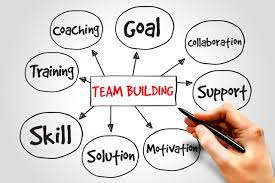One of the main task for any Scrum Master is to manage and motivate the development team (do not forget the Product Owner) to deliver the best-in-class output with outcome to the respective end-users / stakeholders. Pure Agile / Scrum processes will not achieve this, A Scrum Master above all else should be a people person.

During the life of the product development, Scrum Master would enable / facilitate creating a range of tangible deliverables that are critical to the meeting of DoD and release to the production. These would include Impediment board, risks, teaming agreement, cadence of sprint and so on… The funny part of the story is that when the product is delivered all the tangible outputs that we are speaking about would be of no use (atleast to the end-user community). They have little or no value outside the life of the product.
It is important for us to understand that Scrum is all about people, who help to create beautiful and meaningful outputs that serve the needs of the stakeholders and market in general.
The main task for the Scrum Master is to ensure that the development team can deliver and all blockages that occur in the journey of theirs are removed or assisted to be removed.
Over next few paragraphs, we shall de-mystify the needs and requirements on what and how a Scrum Master should enact the approach.
Step # 1 – Get the basics right – Right People, Right Skills, Right Tasks.
As a Scrum Master, help, guide and assist / facilitate the development team to get the right skilled people -with adequate dose of attitude and aptitude. Do not focus on technical skills, focus on learnability, ability to survive in a tough environment, how to respect, being open, have the right level of commitment to the team and others.
There would always be some gap between your needs / wants vs. what talent is available. Remember a perfect match may not be available, try to manage this as a risk and work towards mitigating the same. Try to always get a balanced set of capabilities and skills, do not fall in the trap of choosing all the folks that favor you or you like. Infact look for people who can work with others and create magic for your customers.
Also find a balance between internal and external resources, several times you may be forced by the Leadership to take an internal person (in order to save on cost) but evaluate the person as you would when you take any external resource and ensure it fits in your culture band that you are building in your team.
Step # 2 – Go for Quality rather than Quantity.
More resources may not always be the right approach, but the right resources is what matters. Life and experiences have always suggested that a small set of motivated people have delivered far more than a much larger group of able people. Be the master negotiator with the leadership or the resource allocating person to get the best talent for your team, you may have to act as a salesman to get the right quality in your team (Scrum does not talk about this … but it is critical)
Step # 3 – Clear Roles and Responsibilities.
For any team and individual – we all look for clarity of our roles and expectations, how shall we be judged. Yes, there are no defined / allocated roles in Scrum, but it does not hurt to have pseudo approaches for the initial few sprints and then educate the team to self-allocate, self-define how they want to work out. Scrum Master is like parenting job, initially we would be required to do babysitting, but the as team grows, becomes more mature , our role should be limited to guidance and coaching.
Step # 4 – Building the team
Do not take for granted that Team is automatically built – You need to invest your sweat equity into it.

There is no right or wrong way to build a team, different cultures, different set of people will bond in different lengths of time. To build the team with right values, try these elements:
- Ensure roles are clearly understood
- Ensure communication channels are open between you and the team and amongst the team
- Bring people together (More physically)
- Give people time to know each other
- Have the Product Owner address the team on the needs, vision, big picture, roadmap of the product in focus
Step # 5 – Focus on personal development of team members
It may not be the core objective of Scrum Master, but not focusing on the same would have adverse impact.
Face this task much earlier in the life cycle, ideally when people first get involved in the team, As a part of their initial induction have an understanding of their career needs and wants. The areas where they want to grow and contribute. If their expectations are out of line or un-reasonable, then put it straight on the record.
Help the Product Owner agree to have about 4-6 Hrs / Sprint (Assuming 2 weeks of Sprint cycle) to get it invested in growth, learning of new tools, more on the product development, team building, exploration of new ideas (like using Gen AI to help in the development) and so on … this is a bit of selling exercise with the PO and team (also!)
However, make sure that the training / workshops or getting people involved in specific things do not derail the product development, it should not deviate from the core objective with which the team was formed.
Step # 6 – Be aware of team dynamics and politics
When people work together, they develop their own style of communication. Working together, as a Scrum Master your ability to understand the team dynamics is going to become more critical and critical.
Note: There is no right or wrong team working style or responding to team dynamics. Team dynamics will never remain static, it changes over a period – and when the team matures or new team members join, old ones move on, this can help you rebalance the approach for the team.
Implement PI (Predictive Index Assessment) for everyone on your team. Identify their personalities and ensure you and others in the team understand how to deal with a given personality. This is no rocket science, but not knowing how to deal with a Collaborative vs. Strategists can cause unwarranted losses and damage to the morale of the team and thereby to the product.
Encourage openness and honesty – when these elements are in place, then the team would have few barriers to open communications.
Remember to lead by example if you do not want politics in the team, then do not politic yourself. You want to be trusted by the team.
Final note on this one – Team is more important than any individual, In Agile it is the team that would deliver and not an individual.
Step # 7 – Managing Part time resources
At times, you may not get a fully dedicated person to work on your product development. You would have to work with Shared resources, when such a situation arises, ensure:
- To get fixed and measurable time from shared folks
- Make sure you have sufficient skills and talent and working hands, remember it is not the number of people in your team, but it is the amount time that these folks are ready to devote to you.
- Recommend your team to build a little slack and inefficiency in the approach (this acts like a risk mitigation strategy)
- Your approach to managing the time utilization (not saying to act like a project manager- but watch the game) would be critical to the success of the delivery
Step # 8 – Working with the Wider Organization
Remember your team, the product’s existence is never in isolation. There is always a requirement with some other function, department to get your product out of door, it could be the marketing or the sales team or the travel team (to book your tickets, hotels) or some other platform team whose output would be critical for integration and working of your product.
There is always to a need to manage relationships with the wider organization, and it would vary depending on context and content of the product as developed, Therefore as Scrum Master is it important to guide and assist the team to manage these relationship internally in the system.
Providing adequate and timely notice to dependency would help them plan their side of the work and provide sufficient time allocation for your work.
Step # 9 – Have a sense of humor
The ability to generate and enjoy humor is an extremely positive trait for a Scrum Master. Developing products / projects can at times be quite stressful – the ability to laugh and crack jokes (not on any individual) would help the team manage the stress.

If you are not natural at this … do not worry, just smile a lot. People love to see a smiling face, do not underestimate the power of a simple smile. A well-placed smile of yours can completely change the dynamics of the conversation, can lift an individual from a negative stance to a positive frame of mind.
These are a few ideas that has potentially given me the required results and mind you – it has always worked.
Try it – and then Inspect and Adapt.









